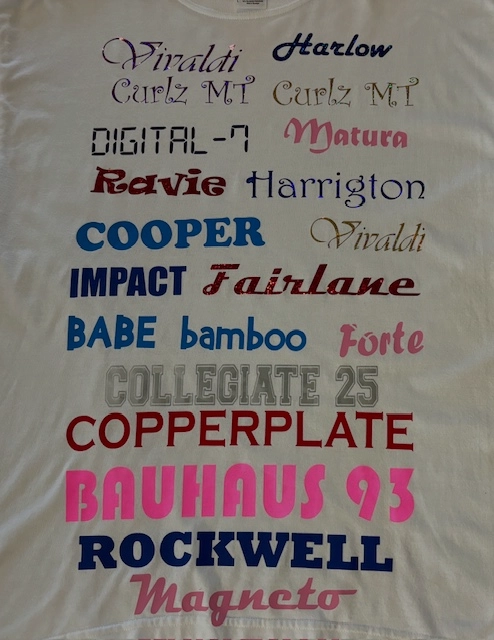Individualized Mugs with Personalized Embroidery Layouts for a Distinct Present
The Art of Personalized Embroidery: Unlocking the Keys to Creating One-of-a-kind and Memorable Layouts
The secrets to creating custom embroidery designs that captivate the eye and leave a lasting impression lie in a delicate equilibrium of method, imagination, and interest to detail. As we delve into the world of custom needlework, we discover the nuanced interplay between string choice, stitch intricacy, and layout personalization that elevates a mere garment to a job of art.
Choosing the Right Embroidery Threads
When picking embroidery strings, what key factors should you take into consideration to make certain the most effective results for your custom styles? The selection of needlework thread is vital in determining the final end result of your embroidered design. One of the key factors to consider is the material of the thread. Various products such as cotton, polyester, rayon, and silk offer varying levels of shine, durability, and structure. It is important to select a thread material that matches the textile you are stitching on and straightens with the desired look of the design.
Furthermore, the weight or thickness of the thread plays a significant role in the appearance of the embroidery. Thicker strings can include measurement and appearance to your layout, while finer strings are excellent for elaborate details and small text. Additionally, thinking about the color fastness and washability of the thread is essential to make sure that your custom-made styles preserve their high quality and vibrancy gradually. By thoroughly assessing these factors and selecting high-quality strings that satisfy your details demands, you can improve the visual appeal and long life of your stitched developments.
Discovering Various Stitch Techniques
To look into the world of 'Checking out Various Stitch Methods', one must realize the ins and outs and nuances that each sewing technique brings to the art of needlework. Different stitch strategies not only include visual interest yet also add to the overall appearance and dimension of the layout. One popular stitch strategy is the satin stitch, which involves very closely jam-packed parallel stitches to develop a smooth and shiny surface area, ideal for completing shapes and producing vibrant describes.
On the various other hand, the backstitch is a versatile method often utilized for outlining and adding fine details. It entails stitching backwards to develop a solid line of embroidery. In addition, the French knot stitch adds a tactile component to designs, best for developing textured accents like blossom facilities or ornamental touches.
Discovering various stitch techniques enables embroiderers to play with light, darkness, and deepness within their layouts, boosting the aesthetic appeal and creative high quality of their needlework tasks. By understanding various stitching techniques, one can unlock limitless opportunities for developing one-of-a-kind and memorable customized embroidery pieces.
Incorporating Personalized Style Aspects
Having discovered the details of various stitch methods such as the satin stitch, backstitch, and French knot, the emphasis currently moves towards including tailored style elements in personalized needlework projects. Individualized style elements play a crucial duty in making embroidery tasks genuinely distinct and remarkable.
One more way to include customized design aspects is by including icons or motifs that hold unique significance to the recipient or mirror their rate of interests and personality. Incorporating a preferred blossom, animal, or hobby-related sign can make the embroidery style more significant and personalized. Furthermore, picking colors that reverberate with the Get More Info recipient or straighten with the designated motif can even more improve the customization of the embroidery Resources task.
Mastering the Art of Shade Sychronisation

One key facet of color control is comprehending shade theory. This consists of knowing exactly how various colors interact with each various other, the feelings they communicate, and how they can be incorporated to create visually enticing styles. By using color concept principles, embroiderers can develop harmonious shade combinations that enhance the total look of the design.
Additionally, taking notice of contrast is crucial in color control. Utilizing contrasting shades can help certain aspects of the style pop, boost legibility, and produce an aesthetically dynamic embroidery piece. By grasping her explanation the art of shade coordination, embroiderers can elevate their styles and develop memorable pieces that resonate with customers and visitors alike.
Enhancing Texture With Advanced Embroidery Stitches
Bullion knots, on the other hand, can be utilized to produce twisted, ropelike aspects that add an extravagant feeling to the needlework. Exploring with these sophisticated embroidery stitches allows you to press the borders of typical needlework and produce genuinely distinct and visually enticing appearances in your styles.
Conclusion
To conclude, the art of custom embroidery entails a combination of choosing the right strings, checking out different stitch techniques, including personalized layout aspects, grasping color control, and improving texture with innovative stitches. By recognizing and executing these crucial elements, embroiderers can develop distinct and memorable layouts that showcase their creativity and ability. Embroidery fanatics can unlock the secrets to creating gorgeous and custom pieces that stand apart and leave a long lasting impression.